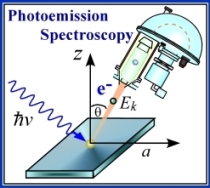Our laboratory activities are primarily focused on the following thrust research areas:
Angle-Resolved Photoemission Spectroscopy :
| A central focus of our research is the investigation of electronic structure in strongly correlated materials, primarily using angle-resolved photoemission spectroscopy (ARPES). Our studies address a range of emergent phenomena, including: (i) metal–insulator transitions (MIT) in transition-metal oxides, (ii) the mechanisms underlying high-Tc superconductivity, (iii) the electronic structure of colossal magnetoresistive (CMR) manganites, (iv) unconventional superconductivity in heavy-fermion systems, (v) charge-density-wave (CDW) instabilities in low-dimensional materials, and (vi) quantum-confined behavior in nanoscale systems, such as ultra-thin films and one-dimensional atomic chains. To probe these complex systems, we make extensive use of synchrotron-based spectroscopies, including XPS (X-ray photoelectron spectroscopy), XAS (X-ray absorption spectroscopy), spectromicroscopy, and both hard and soft ARPES across a broad temperature range, down to cryogenic conditions. | ||
 |
Material Science & Design :
 |
|
|
We design and synthesize novel materials by employing a
variety of controlled synthesis environments. Our laboratory is
equipped with multiple furnace systems, including muffle furnaces, tube
furnaces with inert gas–purging capability, and high-temperature
tube furnaces that allow gas-flow control using Ar, N₂, H₂, and O₂. For
the preparation of compounds such as sulfides and
selenides—materials with low sublimation temperatures—we
utilize very high-temperature Ar arc furnaces and quartz-ampoule
sealing facilities to ensure safe and stable synthesis. Comprehensive
characterization of materials is performed using in-house facilities,
including X-ray diffraction (XRD) at both room and low temperatures,
AFM, SEM, XPS, UPS, SQUID, and four-probe resistivity measurements. |
Nano-Materials : Synthesis, Optical, Magnetic Properties
| We synthesize a wide range of II–VI semiconductor nanoparticles that exhibit light emission when excited by an appropriate energy source. Due to quantum confinement, the band gap of these nanoparticles is strongly size-dependent; therefore, a dispersion containing particles of different sizes can produce broadband (including white) light emission. This approach opens up a promising pathway toward solid-state lighting technologies that could potentially replace conventional fluorescent lamps. Additionally, we introduce transition-metal dopants into these nanocrystals to investigate the magnetic behavior of dilute magnetic semiconductors (DMS), aiming to understand and tailor their spin-related functionalities. A variety of nanoparticle synthesis techniques are established at SSPL, and the materials are comprehensively characterized using UV-Vis absorption, FTIR, ICP-MS, SEM, XRD, XRF, and SQUID facilities. | ||
 |
Theoretical / Computational: Density Functional Theory
 |
|
|
Our experimental findings are supported by
first-principles electronic structure calculations based on density
functional theory (DFT), carried out at SSPL. For strongly correlated
materials and various two-dimensional systems, we employ full-potential
linearized augmented plane-wave (FLAPW) methods (using codes such as
ELK and WIEN2k) as well as ab-initio plane-wave pseudopotential
approaches implemented in VASP and Quantum ESPRESSO. Our current
research emphasis is on spin–orbit coupling (SOC) driven
phenomena in different 2D materials. These computations are performed
using DIRAC, the high-performance supercomputing facility at IISER
Kolkata. |